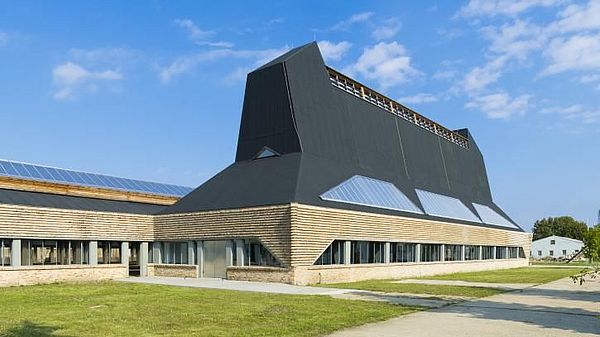On Grand Tour: Exploring Modernism’s Architectural History
Out of the museum and into Bauhaus life: There are many good reasons to hit the road once the Grand Tour of Modernism in Bernau has been launched with a national event on 2nd May. Discover outstanding locations, both of the Bauhaus and of modernism. Pioneering and iconical architecture and unusual buildings – all constructed between 1900 and 2000. The Grand Tour invites you to explore one hundred years of architectural history. We would like to present you with a small but fine selection. Enjoy exploring. We’ll start with four tour destinations in Brandenburg.
The Hat Factory in Luckenwalde
For a long time Luckenwalde, located to the south of Berlin, was one of the most important sites of hat making in Germany. In 1923 Erich Mendelsohn created a plant for the hat factory Steinberg Herrmann & Co. with a prominent roof reminiscent of a hat, which became Luckenwalde’s landmark. His use of reinforced concrete, glass and wood was just as innovative at the time as the structure of the 10,000 sqm hall. He divided it into four bays that are spanned by peaked roofs with skylights.

The music school in Frankfurt an der Oder
The “Staatliche Musikheim Frankfurt“ (State Music School”) wanted to promote a sense of community through dance, acting and music. Otto Barning was the architect of this progressive teaching project. When the building was inaugurated in 1929 each part of the building had a specific function: the elongated timber-framed buildings accommodated the residential section. A bright cubic hall with large window areas was used as theatre hall. The seminar rooms were located in a corridor-like wing, while students could eat and hold round-table talks in the canteen on the ground floor of a tower. There was a lot of space in between so that one could move “freely and rhythmically”

The “Aktivist” in Eisenhüttenstadt
The former HO-restaurant “Aktivist” in Eisenhüttenstadt combines modernism and the past. During the GDR-era adults from all over Eastern Germany came here to eat and to party. Kurt W. Leucht worked on the construction of the building of “Wohnkomplex I bis III” (residential complex I to III) from 1950 to 1960. The Aktivist restaurant was also part of the building complex, whose buildings were in turn part of a “socialist planned city” built in the representative style of “socialist classicism”. More than 20,000 men and women working at the blast furnaces and in the administration of the Ironworks Combine found a new home there.

The Arbeitsamt (“Employment Office”) in Dessau
Gropius was commissioned with the job centre just a few days before he retired from the Bauhaus management. His design won the competition against the works of Hugo Häring and Max Taut. The building’s efficiency fulfilled the needs of the time. In order to find a solution for the full employment offices due to mass unemployment, Gropius came up with a semicircular building in 1929, which he divided into six sectors with individual entrances. The office’s internal organisation defined the office’s layout. Hence those lucky enough to get a job no longer needed to pass by those queuing, but could leave the building via a separate exit – just one of the subtleties of the then totally new type of building.

A Crematorium in Hamburg
The lofty ceremonial hall with its trapezoidal gable is at the centre of the symmetrically designed crematorium in Ohlsdorf. The impressive construction was built in 1932 and is a paragon for the northern German brick expressionism. It was designed by the architect and Werkbund co-founder Fritz Schumacher. In a letter to his brother he stated what he wanted to achieve: “Alongside the painful, which the building is meant to serve, one must also provide for the solemn.” In particular the interior of the hall appears sacred with high, narrow windows, which were colourfully designed by the Hungarian expressionist Ervin Bossányi.

A Winery in Rhineland-Palatinate
Architecture and the enjoyment of wine meet in Kindenheim’s vineyards: In 1929 the architect Otto Prott designed the main building in the style of “Neue Sachlichkeit” (“New Objectivity”). Almost eighty years later the architect Heribert Hamann added an annex to the building further developing the architectural elements of classical modernism in a contemporary way. The Kreutzenberger Winery is on the list of cultural monuments in Rhineland-Palatinate and stands as a unique example of the influence of the Bauhaus on winery architecture.

The Teepott (“Tea Pavillion”) in Warnemünde
If you have ever been to Warnemünde , you will undoubtedly have discovered the city’s landmark between the sea front and the jetty. With the circular building Ulrich Müther and Erich Kaufmann 1968 – assisted by Carl-Heinz Pastor and Hans Fleischhauer – created an important reference of modernism in the GDR. In its lightness and expressiveness it is an alternative to the concrete-slab building method. Müther’s construction became an export hit: in 36 years of professional life he created 70 concrete shell constructions both at home and abroad.

The Diesel Power Plant in Cottbus
The architect Walter Issel designed more than 70 power plants. One of these is in Cottbus and is among his most impressive buildings. Until today both parts of the complex illustrate the great architectural style of the 1920s. With its sober aesthetics the turbine hall represents the New Objectivity. The playful transformer house is characterised by the architecture of Brick Expressionism. Today the complex built in 1927 houses the widely respected museum of modern art.



